
An RNA virus is a virus—other than a retrovirus—that has ribonucleic acid (RNA) as its genetic material. The nucleic acid is usually single-stranded RNA (ssRNA) but it may be double-stranded (dsRNA). Notable human diseases caused by RNA viruses include the common cold, influenza, SARS, MERS, COVID-19, Dengue virus, hepatitis C, hepatitis E, West Nile fever, Ebola virus disease, rabies, polio, mumps, and measles.

Filoviridae is a family of single-stranded negative-sense RNA viruses in the order Mononegavirales. Two members of the family that are commonly known are Ebola virus and Marburg virus. Both viruses, and some of their lesser known relatives, cause severe disease in humans and nonhuman primates in the form of viral hemorrhagic fevers.
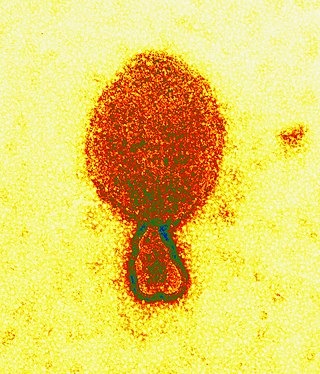
Henipavirus is a genus of negative-strand RNA viruses in the family Paramyxoviridae, order Mononegavirales containing six established species, and numerous others still under study. Henipaviruses are naturally harboured by several species of small mammals, notably pteropid fruit bats, microbats of several species, and shrews. Henipaviruses are characterised by long genomes and a wide host range. Their recent emergence as zoonotic pathogens capable of causing illness and death in domestic animals and humans is a cause of concern.
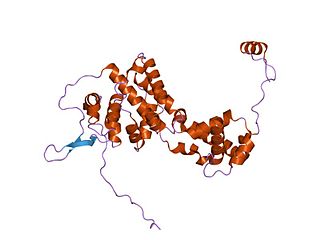
Bornaviridae is a family of negative-strand RNA viruses in the order Mononegavirales. Horses, sheep, cattle, rodents, birds, reptiles, and humans serve as natural hosts. Diseases associated with bornaviruses include Borna disease, a fatal neurologic disease of mammals restricted to central Europe; and proventricular dilatation disease (PDD) in birds. Bornaviruses may cause encephalitis in mammals like horses or sheep. The family includes 11 species assigned to three genera.
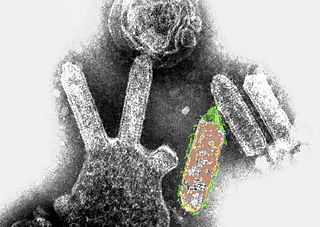
Lyssavirus is a genus of RNA viruses in the family Rhabdoviridae, order Mononegavirales. Mammals, including humans, can serve as natural hosts. The genus Lyssavirus includes the rabies virus traditionally associated with the disease of the same name.

The genus Marburgvirus is the taxonomic home of Marburg marburgvirus, whose members are the two known marburgviruses, Marburg virus (MARV) and Ravn virus (RAVV). Both viruses cause Marburg virus disease in humans and nonhuman primates, a form of viral hemorrhagic fever. Both are select agents, World Health Organization Risk Group 4 Pathogens, National Institutes of Health/National Institute of Allergy and Infectious Diseases Category A Priority Pathogens, Centers for Disease Control and Prevention Category A Bioterrorism Agents, and are listed as Biological Agents for Export Control by the Australia Group.

The genus Ebolavirus is a virological taxon included in the family Filoviridae, order Mononegavirales. The members of this genus are called ebolaviruses, and encode their genome in the form of single-stranded negative-sense RNA. The six known virus species are named for the region where each was originally identified: Bundibugyo ebolavirus, Reston ebolavirus, Sudan ebolavirus, Taï Forest ebolavirus, Zaire ebolavirus, and Bombali ebolavirus. The last is the most recent species to be named and was isolated from Angolan free-tailed bats in Sierra Leone. Each species of the genus Ebolavirus has one member virus, and four of these cause Ebola virus disease (EVD) in humans, a type of hemorrhagic fever having a very high case fatality rate. The Reston virus has caused EVD in other primates. Zaire ebolavirus has the highest mortality rate of the ebolaviruses and is responsible for the largest number of outbreaks of the six known species of the genus, including the 1976 Zaire outbreak and the outbreak with the most deaths (2014).

Vesiculovirus is a genus of negative-sense single-stranded RNA viruses in the family Rhabdoviridae, within the order Mononegavirales.
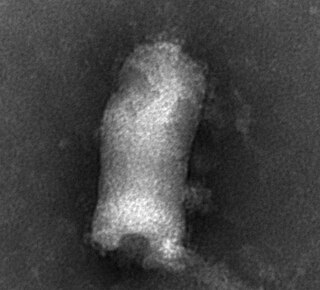
Novirhabdovirus is a genus of the family Rhabdoviridae containing viruses known to infect aquatic hosts. They can be transmitted from fish to fish or by waterborne virus, as well as through contaminated eggs. Replication and thermal inactivation temperatures are generally lower than for other rhabdoviruses, given the cold-blooded nature of their hosts. Hosts include a large and growing range of marine and freshwater fish.

Picornavirales is an order of viruses with vertebrate, invertebrate, protist and plant hosts. The name has a dual etymology. First, picorna- is an acronym for poliovirus, insensitivity to ether, coxsackievirus, orphan virus, rhinovirus, and ribonucleic acid. Secondly, pico-, meaning extremely small, combines with RNA to describe these very small RNA viruses. The order comprises viruses that historically are referred to as picorna-like viruses.
The species Lloviu cuevavirus is the taxonomic home of a virus that forms filamentous virion, Lloviu virus (LLOV). The species is included in the genus Cuevavirus. LLOV is a distant relative of the commonly known Ebola virus and Marburg virus.
The species Taï Forest ebolavirus is a virological taxon included in the genus Ebolavirus, family Filoviridae, order Mononegavirales. The species has a single virus member, Taï Forest virus (TAFV). The members of the species are called Taï Forest ebolaviruses.

Zaire ebolavirus, more commonly known as Ebola virus, is one of six known species within the genus Ebolavirus. Four of the six known ebolaviruses, including EBOV, cause a severe and often fatal hemorrhagic fever in humans and other mammals, known as Ebola virus disease (EVD). Ebola virus has caused the majority of human deaths from EVD, and was the cause of the 2013–2016 epidemic in western Africa, which resulted in at least 28,646 suspected cases and 11,323 confirmed deaths.

Nyamiviridae is a family of negative-strand RNA viruses in the order Mononegavirales. Ecdysozoa and birds serve as natural hosts. The name is a portmanteau of Nyamanini Pan and Midway Atoll and the suffix -viridae used to denote a virus family. There are seven genera in this family.
Aquaparamyxovirus is a genus of viruses in the family Paramyxoviridae, order Mononegavirales. The genus includes two species. Fish serve as the natural hosts for AsaPV, in which the virus may cause proliferative gill inflammation.
Ferlavirus, also referred to as Ophidian paramyxovirus, is a genus of viruses in the family Paramyxoviridae, order Mononegavirales. Reptiles serve as natural hosts. There is currently only one species in this genus to accommodate a single virus, Fer-de-Lance virus (FDLV).
Perhabdovirus is a genus of viruses in the family Rhabdoviridae, order Mononegavirales. Fish serve as natural hosts. Diseases associated with viruses of this genus include: breathing and swimming problems.
Sprivivirus is a genus of viruses in the family Rhabdoviridae, order Mononegavirales. Fish serve as natural hosts.
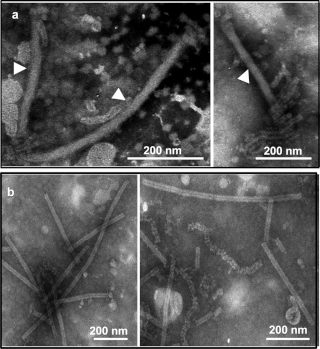
Mymonaviridae is a family of negative-strand RNA viruses in the order Mononegavirales, which infect fungi. Fungi serve as natural hosts. The name is a portmanteau of Ancient Greek myco, which means fungus, and mononegavirales. This family was established to accommodate Sclerotinia sclerotiorum negative-stranded RNA virus 1 (SsNSRV-1) a novel virus discovered in a hypovirulent strain of Sclerotinia sclerotiorum.

Pneumoviridae is a family of negative-strand RNA viruses in the order Mononegavirales. Humans, cattle, and rodents serve as natural hosts. Respiratory tract infections are associated with member viruses such as human respiratory syncytial virus. There are five species in the family which are divided between the genera Metapneumovirus and Orthopneumovirus. The family used to be considered as a sub-family of Paramyxoviridae, but has been reclassified as of 2016.
















